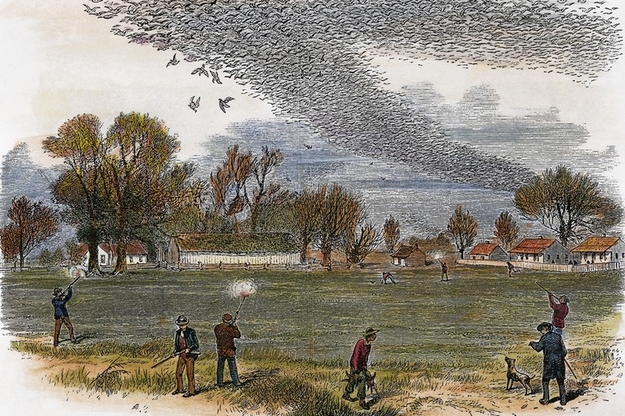The shear sound of their arrival would numb the ears of observers. Trees wept low by the weight of the vast number of birds and their nests. Endemic to North America, this nomadic bird was hunted for decennia by native Americans as a great source of protein. Especially the spring flocks served as a welcome relief from a winter on preserves. However, only when the Europeans arrived was the delicious meat of the pigeons commercialised and sold on markets as cheap meat. Where the native Americans would hunt the pigeons in a sustainable manner, the Europeans practiced an industrial style hunting which led to mass hunts in the 1800s, and the meat was literally falling from the sky as they were shot.
The last individual, a female pigeon named Martha, passed away in 1914 in the Cincinnati Zoo at 29 years of age. The passenger pigeon was run to extinction, haunted by the illusion that no amount of exploitation could endanger a creature so abundant.
This historic event can serve as an example for our current situation with another abundant species, the Japanese knotweed. This species, in contrast to the Passenger Pigeon, is not endemic to the Netherlands but as the name suggests, is native to Japan. As in the 1800s, this plant was praised for its beauty by a Dutch botanist, it was brought to the Netherlands and later also to the UK. Since it did not find a natural enemy here, it spread rapidly. This plant has become an invasive species, causing a lot of distress amongst the Dutch as it breaks through buildings, roads and dominates other plant species. The plant is thriving, and to nobody’s liking. Programs to eradicate this plant have been established for which millions of euros are put aside. However, the attitude here is killing for the sake of killing and it is war. It is a tough battle as new shoots erect from its vast root system each year. Although something can be learned from the case of the passenger pigeon. Namely how effective a mass hunt for food can be.
The shoots of this plant that rise from the earth each spring, where last years plants have wilted, are considered a delicacy in Japan. They have an acidic flavour, reminiscent to rhubarb. Picking these shoots is part of a spring activity where the Japanese go foraging for sansai, mountain vegetables. Maybe eating the Japanese knotweed on a mass scale is our only hope on battling this exotic invader and run it to extinction. “If you can’t beat it, eat it!”.
